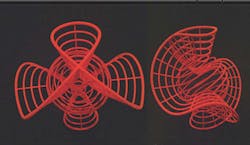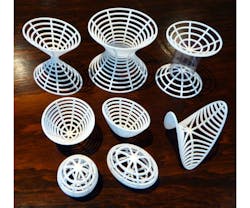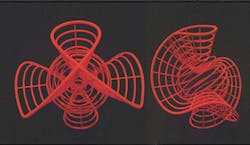This article is abridged from the book, 3D Printing Will Rock the World by John Hornick, available from Amazon.
Kids Are the Key
Kids are just starting to use simple, inexpensive, consumer-grade 3D printers today. They are the early adopters, and machines that are good enough today will become better, faster, and capable of making more things. Kids will not only grow up with the technology, the technology will grow up with the kids because they will contribute to its advancement. Today’s young innovators will 3D print our future. To some extent, they will learn by using their own machines, teaching themselves, and improving the machines as they go. But they will also need access to advanced machines, processes, and materials. Schools and governments are beginning to pave the roads that kids will follow, from printing toys at home today to making high-tech parts and products in the factories of tomorrow.
Turn on the STEAM
There is a lot of talk about the importance of STEM education. Recently, the issue became hotter when STEM became STEAM: Science & Technology interpreted through Engineering & the Arts, all based in Math. According to the US Bureau of Labor Statistics, the United States will have about 9.2 million STEM jobs in 2020. But according to the National Science Foundation, there will not be enough qualified graduates to fill those jobs. Geopolitical expert George Freedman believes the United States will have a severe labor shortage beginning no later than 2020, which will accelerate in that decade.
But there is hope. According to a joint international report spearheaded by the Institute of Electrical and Electronics Engineers (IEEE) Education Society, 3D printing will significantly enhance STEM+ education within a few years.
Inspiring Kids to Learn
Adults often ask, “If I had a 3D printer, what would I do with it?” I answer this question with what I learned from Mark Trageser, an independent toy designer who uses 3D printers to prototype and make toys. He says, “Don’t ask me what to do with a 3D printer, tell me what to do with it.” Many adults need a little help to see how 3D printers can fit into their lives. But kids don’t ask this question. They seem to be born with the innate ability to use technologies available to them. Hand a kid a 3D printer, and he or she will figure out what to make with it. Some of the things they make may not impress you, but I guarantee you that kids will push the envelope, not only of the things they make but also what the machine can do. Kids will do things with 3D printers that we may not think are possible. Why? Because they are not burdened with adult prejudices. Kids don’t know what can’t be done.
STEAMing Up the Classroom
A joint report by the New Media Consortium, the Consortium for School Networking, and the International Society for Technology in Education (“New Media Report”) predicts that full adoption of 3D printing in K–12 education will happen by about 2019.
The beauty of 3D printers in the classroom is that they not only prepare kids to work in the factories of the future and inspire them to be makers but also help bring abstract concepts to life. If a picture says a thousand words, a model you can handle and examine from all angles—and that you made yourself—says a million.
S and T Are for Science and Technology
The New Media Report observes that 3D printers in schools enable, ”More authentic exploration of objects that may not be readily available to schools. In science and history classes, for example, students can make and interact with models of fragile objects such as fossils and artifacts. Through rapid prototyping and production tools, chemistry students can print out models of complex proteins and other molecules."
Students can print models of mechanical devices to see how they work, dinosaur bones to see how they make up a dinosaur, and anatomical models to learn how organs work.
Kids can use home and classroom 3D printers to print cool stuff, have fun, and learn at the same time. For example, the National Institutes of Health created the 3D Print Exchange, which is a free online community-contributed library of 3D printable blueprints. Students who visit the website can download and print tangible models of things like proteins, pathogens, and DNA strands.
There is nothing like studying a physical 3D model. Imagine studying genetics by holding DNA strands that you printed yourself. According to a video on the NIH website, researchers who studied computer models of DNA strands for decades have made important advances faster by studying real, physical 3D models of the strands. Students can also upload their own 3D printable blueprints, so other students can learn from their models.
E Is for Engineering
With a 3D printer, anyone—or even a whole class—can become a mechanical engineer. Eighth graders at Swanson Middle School designed and 3D printed a device to help a disabled student operate the touchscreen interface on his wheelchair.
The 1,650 elementary school students at the Walt Disney Magnet School in Chicago use the 3D printers in their Makers Lab to make objects with Braille labels help teach blind students at a neighboring school.
Engineering with 3D printers is helping more than just the classroom. In 2012, puppeteer Ivan Owen and carpenter Richard Van As started the Robohand project. With the help of a 3D printer donated by MakerBot, they designed a 3D printable prosthetic hand and posted the blueprints on Thingiverse, free for anyone to use and improve. Richard lost his fingers in a woodshop accident. Ivan says, “It’s truly uplifting to see the level of involvement and the number of people out in the world who have taken this idea as their own and are using it to help others.” A new Robohand design is now available, which snaps together like Lego bricks.
A high-school sophomore, Easton LaChappelle took the Robohand project to the next level, combining 3D printed parts with a Nintendo telemetric Power Glove. His prosthetic hand won second place at the Intel International Science and Engineering Fair. At the fair, Easton met a girl with an $80,000 prosthetic arm that she was outgrowing. This spurred Easton to design a new, 3D printed version with the same functionality but at a cost of only $250.
If kids like Easton and Mason had access to more sophisticated machines, they could do more amazing things. But maybe they are better off without them. After all, necessity truly is the mother of invention. The limitations of consumer-grade 3D printers are forcing true innovation in their young users, and kids are just starting to tap the engineering possibilities of 3D printing.
A Is for Art
I’m not sure if the A in STEAM stands for fine art or liberal arts, but I will assume it means both. Certainly 3D printers make art. But they can also be used to print geological formations, historical battlefields, great works of architecture, Leonardo da Vinci’s models, dinosaur bones, ancient stone tablets, and models of Imperial Rome.
Visual aids always help teaching. 3D printing a model of a Roman aqueduct and running water through it—as a class project—gives students a much better understanding of the history, engineering, and architecture than an artist’s drawing in a textbook. Playing with Leonardo da Vinci’s models of submarines, helicopters, and human wings will inspire kids.
M Is for Math
Math models can be 3D printed, which allows students to use their eyes and hands to learn geometry and calculus. Henry Segerman, Saul Schleimer, Drew Armstrong, and Kenneth Baker created the 3D printed math shown below.
Dr. Laura Taalman, professor of mathematics and statistics at James Madison University, worked with her colleagues to build one of the first 3D printing classrooms in the United States, open to all students. Its printers run 24/7. Dr. Taalman uses the machines to teach a branch of applied math called knot theory. Unlike knots tied with rope, mathematical knots can’t be untied.
Before 3D printing, such knots were confined to the mind and drawings in the 2D world. Now students 3D print them, then examine them from all sides. As Dr. Taalman said, “It’s pretty exciting for the students and really gets their attention. I think that having them look at and handle the knots adds to their comprehension of the concepts.” Her courses—“Fabrication of 2D and 3D Mathematical Objects” and “Knot Theory Research and 3D Printing” are typically full.
Self-Education through Making
Kids also have an amazing ability to teach themselves. In fact, most of what they learn, and many of life’s important lessons, they learn outside the classroom. When I was a kid, I tinkered with parts of an old Bell Telephone switching system my father found in a junkyard and taught myself electronics by building simple circuits. I had my whole room wired from a central control panel. My friends were makers too. We learned construction techniques by trial and error by building forts in the woods and tree houses in unlucky trees.
Today, some kids’ lives are much more structured, but they have access to an unprecedented array of tools that allows them to feed their maker nature, including 3D printers. In fact, most consumer-grade 3D printers owe their existence to makers. One resource available today, which I lacked as a kid, is maker and hackerspaces and fab labs. According to MIT’s Neil Gershenfeld, the number of fab labs is doubling every eighteen months. These spaces give kids the tools they need to make whatever they want and the freedom to do it their own way, on their own time, with the influence and support of their peers, and away from control. As Dr. Gershenfeld aptly observed, “The real strength of a fab lab is not technical; it is social. The innovative people that drive a knowledge economy share a common trait: by definition, they are not good at following rules. To be able to invent, people need to question assumptions. They need to study and work in environments where it is safe to do that.”
Maker and hackerspaces allow kids to get away from authority, talk their own jargon, and give their creative minds free rein with the tools around them. As more and more of these spaces open their doors, more and more unusual, unexpected, and out-of-the-box creations will result.
Kids with an entrepreneurial spirit will not stop when things come out of their machines. Some will turn them into businesses. One such kid is teenage Netherlander Maarten van Gelderen, who started his own 3D printing marketplace, Dhreams, for things to print at home. According to van Gelderen,“I want to make 3D printing more visible for the normal people. I have always been interested in 3D printing, but only the major companies were visible for me as a normal person. And they were companies who offer services to print products. What I was missing was a visible place for 3D printable designs. So I founded dhreams.com.”
John Hornick is a partner with the Finnegan IP law firm, based in Washington, D.C. (www.finnegan.com; [email protected]). Any opinions in this article are not those of the firm and are not legal advice.
Looking for parts? Go to SourceESB.


